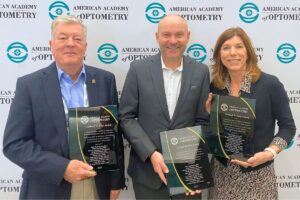Until recently, when a child became nearsighted (myopic), there wasn’t much an optometrist could do except prescribe glasses – and typically strengthen the lenses again and again as the child’s prescription continued to increase. Today, that’s changed – in part due to a long-term study that established the safety and effectiveness of myopia control contact lenses.
Dr. Debbie Jones, a clinical professor at the University of Waterloo School of Optometry and Vision Science and lead clinical scientist at the Centre for Ocular Research & Education (CORE), is part of the group behind that international study. She and her study co-authors were recently recognized with the Garland W. Clay Award at the American Academy of Optometry meeting in Boston.
The Garland W. Clay Award is presented to the authors of the most important paper published by the journal Optometry and Vision Science in the preceding five years.
It’s the second time the group – with some changes in membership – has won the award. The first time was in 2021, when it won for a paper on the first three years of the study. This time, the award is for the paper published on the full six years of the study, “Long-term Effect of Dual-focus Contact Lenses on Myopia Progression in Children: A 6-year Multicenter Clinical Trial.”
“This study really paved the way for myopia control,” says Jones. “It was a huge study, so everyone who participated deserves to be recognized – the researchers who developed the product, the participants and their parents, the clinicians who saw them, the staff who scheduled the appointments and dispensed the lenses – and everyone else behind the scenes.”

The Science Behind MiSight Lenses
The study aimed to establish whether dual-focus contact lenses developed by CooperVision worked to control myopia. Beginning in 2012, nearsighted children eight to 12 years of age were given daily disposable contact lenses to wear. For the first three years of the study, half the children were randomly assigned to receive regular single-vision lenses while the other half received the dual focus lenses, named MiSight.
A different University of Waterloo team – Drs. Elizabeth Irving, Jacob Sivak and Murchison Callender – had previously established that eye growth is controlled by the light coming into the eyes. Their 1992 paper was recently named the most impactful paper published since 1981 by the journal Ophthalmic and Physiological Optics. The MiSight contact lenses aimed to take advantage of the finding that light controls eye growth.
With regular single-vision lenses, vision is corrected so that the light coming through the centre of the lens is focused on the retina, which is good, since it helps people see clearly. However, the light coming into the periphery of the vision focuses behind the retina, which gives developing eyes a signal to grow longer, causing nearsightedness.
The MiSight lenses correct central vision the same way a regular lens does. However, in the periphery, two ring-shaped treatment zones create defocus so that peripheral light focuses in front of the retina instead of behind. This eliminates the signal to the eye to grow longer.
Six Years of Clinical Results
The study took place at sites in Portugal, the United Kingdom, Singapore and the Centre for Ocular Research and Education at the University of Waterloo. The Canadian site had the largest cohort of participants, with about 50 myopic children enrolled in the study.
In the first three years of the study, the children who received the MiSight lenses had significantly slower eye growth and therefore less progression of myopia than the control group.
The difference was so marked that the scientists involved in the research decided they could not ethically continue the study with half the children unable to benefit from the technology. Therefore, in the second half of the study, all the children received MiSight lenses.
The second half of the study found that even with a later start, most children and youth using the dual-focus contact lenses benefited from slower myopia progression and eye growth. It also found that children who received the test lenses in the first half of the study continued to benefit over the full six years.
Transforming the Standard of Care
The groundbreaking study has not only been heavily cited, it has led to a paradigm shift in the treatment of myopic children.
MiSight lenses, the only FDA-approved myopia control soft contact lens, are widely available internationally. Children who use them are likely to end up less myopic than they otherwise could have been, which means they’ll be at lower risk of sight-threatening conditions such as retinal detachment and myopic maculopathy when they get older.
“The study gives clinicians the confidence that they can trust the product, because there’s good, solid clinical data behind it,” says Jones. “With the incidence of myopia skyrocketing, we’ve known for a long time we should be doing something. Now we know what to do.”
Canada became the first country to declare myopia management the standard of care for children – Jones received the Canadian Association of Optometrists President’s Award in 2023 for her work advocating for the change.
Jones’s co-authors are Paul Chamberlain, Arthur Bradley, Baskar Arumugam, David Hammond and John McNally (CooperVision); Nicola Logan (Aston University, UK); Cheryl Ngo (National University Hospital Singapore); Sofia C. Peixoto-de-Matos (University of Minho, Portugal); and Chris Hunt and Graeme Young (Visioncare Research Ltd).